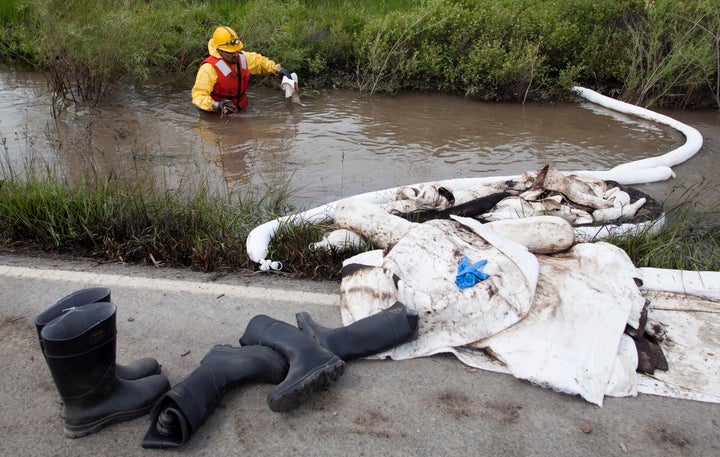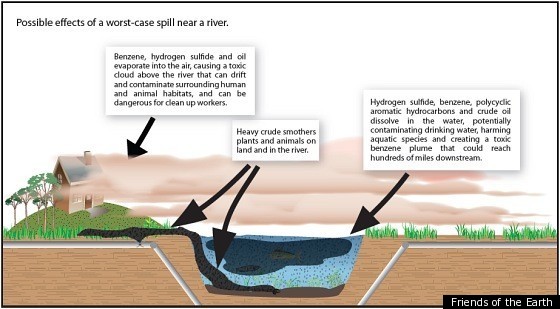
It's a scene that has become all too familiar in recent months: thick, black oil washing up on some shoreline as workers in protective gear try to stop its spread. The most memorable, and most destructive, recent oil spill occurred last April in the Gulf of Mexico.
Since the disaster in the Gulf, dozens of pipelines have spilled millions of gallons of oil into streams and rivers across the continent. A year ago, an Enbridge pipeline poured more than 800,000 gallons of tar sands crude into a tributary of the Kalamazoo River, near where I grew up. In May, a Plains All American pipeline that carries tar sands oil spilled more than a million gallons in the Peace Region of Northern Alberta.
And, over the 4th of July weekend, ExxonMobil's Silvertip pipeline ruptured, gushing more than 42,000 gallons of oil into the Yellowstone River in Montana. Pipeline disasters destroy ecosystems and lives.
Yet as a raging river complicates cleanup efforts along the Yellowstone, an even bigger and more dangerous pipeline is in the works. The oil industry is pushing the Obama administration to approve a permit for TransCanada's Keystone XL pipeline, a tar sands oil project that would stretch from Canada to Texas, crossing the Yellowstone and Missouri Rivers in Montana, the Platte River and the nation's largest aquifer, the Ogallala, in Nebraska, and dozens more rivers and streams. Moreover, the Keystone XL would carry highly polluting tar sands oil from the most destructive project on the planet. Leading climate scientist James Hansen has warned that exploiting the full potential of Canada's tar sands could trigger the uncontrollable over-heating of our planet.
This pipeline will spill -- the only question is how soon and how badly. Secretary of Transportation Ray LaHood, has ordered ExxonMobil to increase its safety precautions before restarting the Silvertip pipeline, but as Anthony Swift at the Natural Resources Defense Council pointed out last week, the pipeline was already up to code and operating legally before the spill. Even for a traditional oil pipeline, the current regulations do not ensure safe operation.
The proposed Keystone XL pipeline, however, is not a traditional oil pipeline by any definition. First, it's a monster -- stretching nearly 2,000 miles end-to-end, the pipeline would be three times the diameter of the Silvertip, and would carry up to 900,000 barrels of oil a day, more than 20 times the Silvertip's volume.
Second, it would transport tar sands oil, not the traditional oil carried by the Silvertip. The tar sands contain an oil-like chemical called bitumen, which is more solid than liquid at room temperature, so it must be diluted with other volatile liquids and is transported as "diluted bitumen," DilBit for short. DilBit can corrode pipelines faster than traditional oil because it is more acidic than regular crude oil, contains more abrasive particles, and is pumped at higher pressures and temperatures. Despite the increased risk, the Pipeline and Hazardous Materials Safety Administration does not require any additional safeguards for a DilBit pipeline.
Safety matters: more than 99 percent of the Keystone XL will be comprised of half-inch-thick steel pipe, the same thickness that failed in the Yellowstone River. But it's not clear that TransCanada is concerned. The company applied for a safety waiver to use even higher pressure in an even thinner pipe, but withdrew the application under public pressure. TransCanada already has one tar sands pipeline in operation, Keystone I, which has leaked 33 times in just its first year of operation.
With the corrosive properties of the DilBit and the less-than-impressive safety record of TransCanada and the rest of the pipeline industry, it is undeniable that spills will happen. TransCanada has yet to produce an analysis of the worst-case spill scenario, as required by the Clean Water Act, so yesterday a professor of environmental engineering at the University of Nebraska, Dr. John Stansbury, released his own analysis to arm decision makers with as much information as possible.
Suffice it to say, Dr. Stansbury's findings show the results of a spill could be catastrophic. A worst-case spill on the Platte River in Nebraska could send a plume of water contaminated with carcinogenic benzene as far south as Kansas City, Missouri, threatening the drinking water of hundreds of thousands of people. Literally millions of gallons of oil could spill into the fragile ecosystem of Nebraska's Sandhills, which lie atop the Ogallala Aquifer, a source of drinking water to more than two million people. TransCanada admits that a small leak could go undetected for up to 90 days, and even a large leak in a remote area could go undetected for up to two weeks, the interval between regular aircraft inspections.

Even still, the company has consistently downplayed the potential damages. TransCanada claims it would shut down the pipeline within 11.5 minutes of a spill, but ExxonMobil needed an hour and Enbridge needed twelve hours to shut down their pipelines. TransCanada's spill assessment assumed that the construction of the Keystone XL would be so much better than other pipelines that it would rupture half as often -- Keystone I's dismal record does not back up the assumption. Also, TransCanada's methodology for predicting spills simply ignores historical data on spills with unknown causes, which account for nearly a quarter of recorded spills. In Dr. Stansbury's independent assessment, the Keystone XL is nearly nine times more likely to experience a significant spill than TransCanada claims.
So what's the solution? First, more stringent pipeline regulations that take into account the differences between DilBit and traditional oil are necessary. These stricter rules should also do everything possible to protect the environment -- any oil spilled into a pristine river or source of drinking water is too much.
Second and more importantly, as I said on MSNBC last week, we need to get this country off oil. Increased fuel economy standards and other ways of improving efficiency will be a good first step, but we, as a nation, need to make a concerted effort to move toward renewable sources of energy. There is too much at stake. Our dependence on oil is an ongoing series of disasters -- obvious ones like oil spills, and less tangible, but even more threatening ones like climate change.
And finally, Secretary Clinton and the administration must reject this tar sands oil pipeline. You can take action and tell the administration to stop the Keystone XL pipeline.
